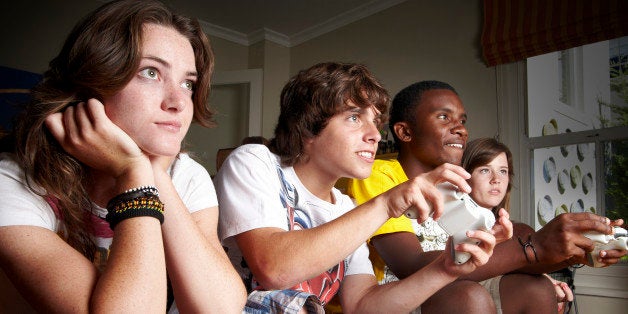
Video gaming is what rock and roll was in the 1950s. It's a movement. And my generation of middle-agers should know by now that you can't fight a movement -- especially when you were once part of a different movement -- the same way our parents were once part of a movement that their parents didn't understand. How far have we come in bridging the generation gap through more than three generations? Not far. And we need to do a better job as adults with the current generation of youth.
Yes, while the parents of our grandparents were listening to Frank Sinatra, Perry Como and big bands, our now grey-haired patriarchs and matriarchs with bad hips were twisting and grinding to the scandalous rhythms of rock and roll. Yes, the now-seemingly innocent sounds which emanate from the oldies radio stations were once considered "the devil's music." Rock and roll was blamed for nearly every social ill of the time the same way video gaming has been targeted recently. The truth is a lot of good came from rock and roll in terms of social change... the same way it can from video gaming now.
Fast forward to today when we are at a very different critical state in America after placing fifth behind Sweden, Singapore, Finland and Switzerland in our use of technology which I believe is a direct bridge to being a more innovative nation. The study was conducted through the World Economic Forum and also found that the U.S. placed 24th in households with technology, 76th in mobile phones, and 52nd in math and science education. That last number is staggering with the backdrop of 25 percent of current STEM (science, technology, engineering and math) workers foreign born and 10,000 Baby-Boomers reaching retirement age every day for the next 20 years.
America needs another youth movement but this time in the innovation space.
So there I stood, absolutely mesmerized watching my five-year-old son adroitly maneuver through a complicated, life-like, labyrinth of activity and nefarious characters to accomplish his mission while sipping a juice box and adding plenty of body English. I was interrupted by my wife asking if we were having fun during our "big boy" time together while she was with my daughters at ballet. "Yeah, except the only problem is that I can't compete with him on the video game," I said. "But I made a deal that if he played soccer with me I would play video games with him. It's really remarkable how natural the technology is to him. Almost organic."
Organic indeed. My son was born listening to lullabies on my smart phone, watching favorite toddler Disney and Nick Jr. videos on the tablet, and now plays video games that actually feature characters from my generation including Batman, Indiana Jones, Mario Bros. and new characters like Skylander Giants. He was born cuddling technology the way I was with my favorite blankie. He is a true digital native.
I have discovered that my cherub-faced, floppy-haired, kindergarten-aged, gamer offspring isn't alone. According to a national survey conducted by the National Institute on Media and the Family (NIMF), 92 percent of children and adolescents aged two - 17 play video games and global video game market revenue including smart phones and tablets is $66 billion and expected to hit nearly $80 billion within the next three years. A recent video game debuted with more than $800 million in sales in just 24 hours! As the grown-ups, we need to leverage video gaming's tremendous popularity as an effective tool for America's youth to innovate and affect social change -- especially with minorities who play more video games than white youth according to a study by the Kaiser Family Foundation -- many of whom are considered disconnected youth.
"Educating our children in the STEM fields of technology is essential to our nation's competitiveness and to a growing economy," said Congressman Ben Rey Luján (D-NM) who is always challenging how we engage youth to innovate and is a member of the Democratic Caucus' Jobs Task Force.
As our younger generations grow up with technology at their fingertips from their beginning years, it offers us an opportunity to get them excited about a career in the STEM fields that allows them to not just use the latest advanced technologies, but dream and create the next great innovation.
My organization, the Hispanic Heritage Foundation, is doing our part by partnering with the Entertainment Software Association and other nonprofits through a national initiative which challenges minority youth aged 16 - 24 to design a video game that addresses social issues in an effort to encourage social innovation among youth on their terms -- through platforms they feel most comfortable -- in this case video gaming and phone apps. Through this program, 20 youths will be selected and will visit D.C. and present their ideas to influencers and receive an "Innovation Grant." (Watch for video here.)
"What's great about the ESA LOFT Video Game Innovation Fellowship is that it's focused around a medium that is popular with today's youths," Rich Taylor, senior vice president of communications and industry affairs at the ESA.
Its unique because it's asking talented young people to transition from video game consumers to game creators, and the fellowship tasks them to create change in their communities through games.
According to an article by Suzanne Kantra, the University of Rochester found that individuals who played action-based games made decisions 25 percent faster than others without sacrificing accuracy and can pay attention to more things at once. The Office of Naval Research has found that games improve the fundamental ability to reason and problem solve in new contexts. And kids who play video games scored 23 percent higher in creative tests involving tasks such as drawing pictures and writing stories, according to Michigan State University. Kantra went on to write that there are also physical benefits including faster reaction times, better hand-eye coordination and manual dexterity. These studies were not lost on educators and museum directors who have also started leveraging the technology as a teaching tool. Dr. Jeffrey Taekman, Director of Duke University's Human Simulation and Patient Safety Center stated on the subject, "Serious games and virtual environments are the future of education."
America needs to take advantage of our youth's interest in technology to climb back atop the global rankings and fill the nearly three million STEM-related vacant jobs, and video gaming is an effective gateway. Dr. Michael Rich, who is a pediatrician at Children's Hospital Boston and directs the Center on Media and Child Health, said in an article that we need to stop arguing over whether using media including video games and phone apps was good or bad and just accept it as part of children's environment, "like the air they breathe, the water they drink and the food they eat."
The same way another generation had to do with rock and roll. The difference being that rock and roll actually peaked in the late '60s and '70s (yes, that was my generation!) and with video gaming, we are just getting started.
